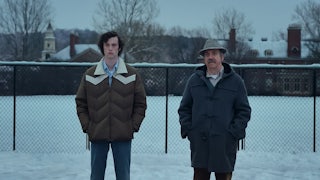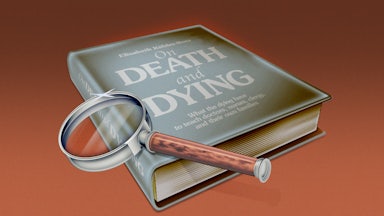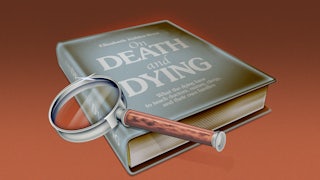In Luca Guadagnino’s 2022 film, Bones and All, Maren (Taylor Russell) and Lee (Timothee Chalamet) were cannibals in love. “I don’t wanna hurt anybody,” Maren tells Travis weakly, to which he drawls in reply: “Famous last words.” This exchange serves as a pretty apt comment on Guadagnino’s body of work: His specialty is emotional devastation, violent and gorgeous, as characters choke on love and, sometimes, their own bile. In many ways a road movie, with postindustrial sunset imagery to spare, Bones and All was lean but fleshy, a bone bruise committed to film.
If cannibals and teenagers have one thing in common, it’s Big Feelings, and Bones and All was a heightened epilogue to Guadagnino’s “Desire Trilogy”: the 2009 film I Am Love, 2015’s A Bigger Splash, and 2017’s Call Me By Your Name. These films shared a preoccupation with not just love but with love triangles, as well as three-way encounters, both literal and literary. Bones and All made Maren choose between her mother’s curse and her father’s pleas to reform. I Am Love showed a wealthy woman torn between her husband, family, and privileged existence and the handsome young chef who threatens all of it. Call Me By Your Name gave us two leads torn between their respective girlfriends and one another, between heteronormativity and unbridled attraction. That said, the most memorable triangle transpires between a man, a boy, and a peach.
In a way, you—or we—are the peach. All cinematic sex scenes, but Guadagnino’s textured sequences in particular, are a ménage à trois, in which the third, voyeuristic party is the audience. We are a party to the seduction; we are the long shot, we are the close-up; without us, the sex wouldn’t be a scene. This is probably why some people get so uptight about sex scenes, why others defend horny screen art to the death, and why these debates, largely conducted over social media, can fall into unwitting self-parody.
Guadagnino’s new film, Challengers, is being billed as the movie where Zendaya does a three-way, additionally provocative because there’s only one girl in this triangle. Her character, Tashi Duncan, is a teen tennis sensation, with numerous sponsorships and an illustrious foundation to her name. She’s a top-tier celebrity at the U.S. Open, while the two puppyish boys in question, Art (Mike Faist) and Patrick (Josh O’Connor), are rising stars at best and longtime best friends. They invite Tashi back to their seedy motel room, hoping she’ll choose one of them, but naturally it’s not that simple.
A three-way sex scene can be a plot point, but it is just as often a metaphor or a marketing ploy. Josh O’Connor demonstrated his flair for P.R. when he told Vanity Fair that there was “an element of improvisation” with the scene, adding “it was fairly organic.” In an age of intimacy coordinators, this titillating disclosure promises a glimmer of authenticity. So, let’s get this out of the way: This triangular hookup is the tamest thing in Challengers.
It is just one of many sequences in which the three characters are shuffled into various pairings and triads, each permutation laden with its own emotional and erotic baggage. Even before the logo of Metro-Goldwyn-Mayer appears (see? Three again! M-G-M!), the movie opens with extreme close-ups of Tashi, Art, and Patrick’s squinting visages; in the climactic finale, Tashi is superimposed onto the tennis match, positioned between Art and Patrick, as the two men vie for a crummy title and their lady’s approval.
The most vigorous thing about Challengers is its muscular structure, the film edited together like a rollicking face-off, shooting between the past and the present like a tennis ball at top speed. The plot follows Tashi, Art, and Patrick through their youthful indiscretions to the shifting alliances and betrayals they manage as three embittered adults. The story races into the present or gets pulled back into the past by a character’s memory or their secret, with cliff-hangers that feel soapy and maybe a little hokey too.
This movement between time frames could be confusing, but Guadagnino ensures legibility at every turn. Descriptive, superimposed text helps, as do the haircuts: Tashi and Art have wild, curly locks when they’re young and carefree, but rock-shorn, chic ’dos as a famous power couple: “Game Changer” reads their ad collaboration with Aston Martin. (Tashi wields a red marker and adds “s” to the end, which tells you everything you need to know about their emotional dynamic.) Meanwhile, Patrick’s hair remains messy throughout, intended as a marker of his immaturity and his enduring sex appeal.
Challengers hails the voyeuristic spectator at every turn: It’s a movie as much about watching as about performing, as much about scopophilia as exhibitionism. The camera loves Zendaya, following her around in her radiant, wealthy wardrobe, all beige and cream and dry-clean-only. Her character, injured early in the film, mostly witnesses the action from the sidelines. In a flashback, Art and Patrick watch Tashi smash the competition, reclining in perfect unison as throwback synth music plays.
It may be no surprise that Guadagnino’s take on a sports movie is somewhat askew. Challengers is not an erotic thriller set in the world of tennis either, à la Match Point, and no one is as cute or likable as the leads of the romantic comedy Wimbledon. It’s hard to characterize what he’s created in these 131 minutes. Is it a tennis movie put through the art cinema machine? A pastiche of sports movies? Is Challengers a movie about movies (as most movies are), where tennis is the operative metaphor for cinema and how it moves the body?
What is for sure is how often the main characters are discussing tennis, debating tennis, asking each other, Are you talking about tennis right now? Are we still talking about tennis? Mommy, are you ever going to cool it with the tennis talk? The dialogue is, one imagines, intentionally over the top. For the men, tennis is a placeholder for sex and power, a constant negotiation over who will gain Tashi’s body, heart, and athletic expertise. For Tashi, everything in her adult life is a consolation prize for her lost potential as a champion. “Tennis is a relationship,” she muses, recalling a mediocre opponent she utterly destroyed on the court. For 15 seconds, she professes generously, “it was like we were in love.”
For Tashi, tennis is not love: Love is tennis. When forced to choose between a man-child who needs to be held until he falls asleep and a trust fund baby looking for a backseat romp and a place to shower, is it any wonder she chooses the sport of kings?
The film is about as romantic as its female lead, which is to say, not very. Challengers runs on endorphins, not dopamine, and its very form gives you a workout: the wild intercutting, the talking about talking about tennis, Zendaya’s runway strut, Josh O’Connor’s acting opposite a churro. The cinematography is, at turns, hypnotic and jarring, as balls fly at the lens, sweat pours down on the viewer, actors fleetingly break the fourth wall and gaze lovingly at you (yes, you). The image of Tashi’s career-ending injury is shot so brutally, in such close quarters, that it feels like a personal, visceral injury for the spectator. But Challengers’ aggressive energy is best exemplified by Trent Reznor and Atticus Ross’s loud, intrusive soundtrack—varied, weird, and synth-heavy—which plays over quiet and flashy moments alike.
In short, Challengers’ confrontational, music video vibe is its true kink. The film is careful about how it tells the story, but seems to suggest that spectacle—not narrative, not even psychological continuity—is all that matters. This argument is line-driven home by Challengers’ concluding shot, a cut to black so bananas, somehow both earned and unhinged, that I near-yelled “What?!” in a crowded press screening. It’s less an ending than a punch line, making you wonder if what you’ve really been watching is a fashion-forward comedy. But what’s the joke? And who’s it on?
Of all of Guadagnino’s features, Challengers’ most fitting doubles partner might be 2015’s A Bigger Splash, in which four rich nightmares circle each other, like sexy caged animals, against an opulent tropical backdrop. The group includes Harry (Ralph Fiennes), a smarmy record producer with a hammer and sickle tattoo, and his ex, Marianne (Tilda Swinton), a famous singer with a lost voice. Guadagnino stages charged glares and silences around tastefully weathered picnic tables and impeccably maintained swimming pools. Don’t let the rectangles distract you: This one is triangles straight down the line too.
Marianne, like Tashi, is an artist whose craft is hobbled as she is pulled between two flawed men. Tensions escalate between Harry and Marianne’s current boyfriend, Paul (Matthias Schoenaerts), who is as calm and grounding as Harry is dynamic and destructive. “You don’t deserve either of them,” Harry snipes, referring to Marianne and his daughter, Penelope (Dakota Johnson). “Neither do you,” Paul fires back.
Like A Bigger Splash, Challengers is a movie about an emotionally remote goddess and the sweaty, unworthy men who love her. Both films center on luminaries who, to paraphrase F. Scott Fitzgerald, are careless and smash things up. Stopping just short of grotesque, A Bigger Splash is a precursor to our current “eat the rich” cycle, a satire promising that, if left to their own devices, the bored, egotistical elite will eventually eat each other.
Challengers shares many of the same preoccupations as A Bigger Splash, though it is less coherent or legible as a genre film. It could belong, with Bones and All, to what is becoming Guadagnino’s post-Desire trilogy. If Bones and All’s relationship to longing produces a fraught morality play, Challengers offers a robust, cheeky spoof of pleasure. What comes after desire? Suffering, on the one hand; stylized, unserious camp on the other. It hurts so good to play; it hurts better to win; it hurts best to watch.






